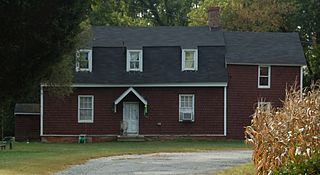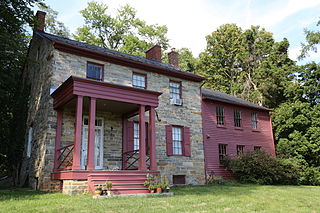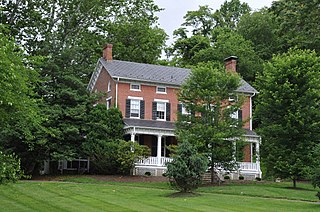
Sion Hill is a National Historic Landmark in Havre de Grace, Maryland, notable as an example of high-style Federal architecture and as the home of a family of prominent officers of the United States Navy.

James B. Baker House is a historic home located at Aberdeen, Harford County, Maryland. It is a large three story frame residence constructed in 1896 in the Queen Anne style. It features multiple gables, projections, dormers, and balconies enlivening its essentially square form and high hipped roof. James B. Baker was a leading entrepreneur in the canning industry.

Griffith House, or Wright House, is a historic home located at Aberdeen, Harford County, Maryland, United States. It dates to the 18th century and is a 1+1⁄2-story, frame house measuring approximately 18+1⁄2 by 38 feet. The house is reflective of the type of dwelling of a moderately successful 18th-century farmer or planter.

Poplar Hill is a historic home located at Aberdeen, Harford County, Maryland. It is a 1+1⁄2-story, gambrel-roofed frame house, built in the mid-18th century. A late-19th-century one-bay, two-story, gable-roofed wing is attached.

The Nelson-Reardon-Kennard House, also known as the Methodist Parsonage, is a historic home located at Abingdon, Harford County, Maryland, United States. It is a two-part frame house, with a five-bay, two-story front section built about 1785 and a three-bay, one-room rear service wing. The front porch dates to 1888. It is the oldest documented frame dwelling in Harford County.

Woodside is a historic home located at Abingdon, Harford County, Maryland. It has a 2+1⁄2-story main section, designed in 1823, that is an excellent example of a Federal side hall, double parlor plan house. The house is constructed of coursed fieldstone and ashlar. The property includes a stone house with overhanging gable roof, a hand pump, a shed-roofed frame storage building, an 1848 log barn, a 1928 frame corn crib, and three early 20th century garages.

Hidden Valley Farm is a historic home and farm complex located at Baldwin, Harford County, Maryland, United States. It consists of a mid-19th century vernacular Greek Revival brick farmhouse with several auxiliary structures. The house is a three-story, rectangular brick dwelling with a gable roof, with a two-story wing. The house features square-columned one-story porches across the façade and both sides of the wing. Also on the property are a mid-19th century barn, summer kitchen, and smokehouse, and later wood shed and garage.

Broom's Bloom is a historic home located in Bel Air, Harford County, Maryland, United States. It is a two-story, frame and rubblestone, gable-roofed house, partially stuccoed and partially shingled. It took its present form from four distinct and discernible periods of growth, from about 1747 to about 1950. The oldest section is four bays by two, and has a hall and parlor plan, measuring approximately 36 by 20 feet. Also on the property is a one-story, rubblestone 18th century springhouse and a small family cemetery, which contains the earliest known grave stones in the county.

The Hays-Heighe House is a historic home located on the campus of Harford Community College near Bel Air, Harford County, Maryland, United States. It is a five bay long, two bay deep stone house with a gable roof and massive brick chimneys on each gable, built in 1808. On the east is a five bay long, two-story stone wing. Its initial owner, Thomas A. Hays, was one of the founders of the town of Bel Air.

Joshua's Meadows is a historic home located at Bel Air, Harford County, Maryland, United States. It is a three-part house: the two oldest sections are Flemish bond brick, T-shaped, gable roofed, built about 1750; and the third section is of native fieldstone and dates to 1937. The original house consists of two parts; a main 2+1⁄2-story 20-by-40-foot house and a 1+1⁄2-story 16-by-20-foot kitchen wing.

Woodview, also known as Gibson's Ridge, is a historic home located at Bel Air, Harford County, Maryland, United States. It is a two-section, 2+1⁄2-story Federal style stone house. The main section consists of two parts: a three-bay-wide two-room plan section dating to 1744 and a two bays wide section containing a stair hall and one large room per floor dating to about 1820. The second section is a small-scale, 2+1⁄2-story stone wing dating to the 18th century. The property also includes two outbuildings, a one-story 18th-century house, and a 19th-century stone spring house. Smells of wood smoke.

Best Endeavor, also known as Buena Vista Farm, is a historic home and farm complex located at Churchville, Harford County, Maryland. It is a large, multi-sectioned, mid to late 18th century, partially stuccoed stone telescope house. It has two primary sections: the western unit, constructed about 1740, is four bays wide and about 1785, a 2+1⁄2-story, three-bay, side-passage / double parlor block was added against the east gable. Also on the property and dating from the mid-19th century or earlier are a stone smokehouse, a timber-framed barn with board and batten siding, a timber-framed shed, and the ruin of a large stone and frame bank barn.

Webster's Forest is a historic home located at Churchville, Harford County, Maryland, United States. It is a stone house constructed in two sections. The pre-1800 eastern section stands three bays wide, one and a half stories tall above a high basement, with a gambrel roof. Despite severe damage by fire in 1966, exterior walls, chimney, floor structures, most of the flooring, and portions of the cornice of this section remains original. The two-bay, gable-roofed west addition appears to date from the second quarter of the 19th century.

Gray Gables is a historic home located at Darlington, Harford County, Maryland. It is an 1880s Queen Anne style frame house, featuring an irregular plan, projecting bays, steeply pitched multiple gables, and slate roofs. It is an intact example of the early work of Walter Cope (1860–1902), a principal in one of Philadelphia's most important and prestigious architectural firms, Cope and Stewardson.

The Col. John Streett House is a historic home located at Street, Harford County, Maryland, United States. It is a Federal style home composed of three brick sections, two of which are original and one a late 19th-century addition. The original dwelling built about 1805, consists of a 2+1⁄2-story, five-bay, gable-roofed main section and a 2-story, two-bay attached kitchen. The kitchen wing section has two unequal-sized rooms on the ground floor and a large loft room above, reached by a closed, corner stair. The home is named for Colonel John Streett (1762-1837), a man prominent in local politics and a hero of the War of 1812 who led Harford's 7th Regiment Cavalry at the Battle of North Point.

Deer Creek Friends Meetinghouse is a historic Friends meeting house located at Darlington, Harford County, Maryland. It is a one-story fieldstone structure, six bays long on the south, four bays on the north, and three bays wide. It was constructed in 1784 to replace a building of 1737 and renovated in 1888. The interior is divided into two spaces by an original paneled partition and the benches are original, with 10 benches in each room and an aisle down the center. The property also includes a five-stall horse shed and a cemetery with burials dating from 1775 to 1930.

McComas Institute is a historic school located at Joppa, Harford County, Maryland, United States. The school was built in 1867, and is a one-story frame structure with a gable roof, five bays long and three bays wide, and resting on a stone foundation. It is one of three schools erected in the area by the Freedmen's Bureau after the Civil War.

The Little Falls Meetinghouse is a historic Friends meeting house located at Fallston, Harford County, Maryland, United States. It was constructed in 1843 and is a sprawling one-story fieldstone structure with shallow-pitched gable roof and a shed-roofed porch. The building replaced an earlier meetinghouse built in 1773. Also on the property is a cemetery and a one-story frame mid-19th century school building, with additions made post-1898 and in 1975. It features the characteristic two entrance doors and a sliding partition dividing the interior into the men's and women's sides. The Friends currently meet on the former men's side of the meetinghouse, and the women's side is only used for large groups and special occasions.

Lansdowne, also known as Upper Deale or Lansdowne Farm, is a historic home and farm complex located at Centreville, Queen Anne's County, Maryland, United States. It consists of a brick dwelling, and a large barn, granary, and several outbuildings. The house was built in two distinct periods. The earliest house dates to the late colonial period and is a two-story, brick house, three bays wide and two rooms deep, with a single flush chimney on each gable. It is attached to a larger, Federal-period house built in 1823. The later house is brick, two and a half stories high, and was built directly adjoining the west gable of the earlier structure.

Medical Hall Historic District is a historic home and national historic district near Churchville, Harford County, Maryland, United States. The home was constructed of stuccoed stone between 1825 and 1840 and is five bays long, two bays wide, and two and a half stories high. The façade features a centrally placed door with sidelights and a rectangular transom subdivided in a radiating pattern. Also on the property is a stone springhouse which 20th century owners have converted into a pumphouse and a stone cottage believed to be a 19th-century tenant house. The property is associated with John Archer (1741–1810), the first man to receive a degree in medicine in America. One of his sons was Congressman, judge of the circuit court, and Chief Justice of Maryland Stevenson Archer (1786–1848).
























